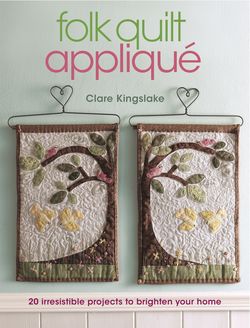Читать книгу Folk Quilt Applique - Clare Kingslake - Страница 5
На сайте Литреса книга снята с продажи.
ОглавлениеFabric Selection
Choosing fabric is a vital, and exciting, part of making a quilt. It is also a very personal thing so be guided by what pleases you. The following advice will help.
Fabric Pattern
Most of my projects are picture-based appliqué. For these types of designs it is important for your eye to be able to see the shapes of the pieces and the overall picture clearly. Using fabrics with a large printed pattern is distracting and camouflages the shapes, so these fabrics are difficult to use successfully. I like to use tone-on-tone fabrics, those with small patterns that do not contrast too much with the background. Plain fabrics show the shapes very clearly and can be very dramatic, but they show every slightest mistake too. If I do use solids I usually add machine or hand embroidery.
For appliqué choose fabrics with small patterns that don’t have too many colours in them. Tone-on-tone fabrics are wonderful for this. The odd fabric can have a larger pattern that can be fussy cut into a flower or circle.
Fabric Colour
Colour is probably the most important aspect of fabric and thread choice. Try to think of the fabrics and threads you choose as making up a paint box of colours. I tend to use a fairly small range of colours on a project, or more particularly a small number of colour families. Rainbow colours have their place but probably not for my quilts. Fabrics will tend to go together well if you can see one of the colours in one fabric echoed in the other.
When you are planning how the fabrics will fit together for the quilt, consider the balance of colours over the whole quilt, and similarly the balance of light and dark. See how the different colours ‘play’ against each other and consider whether a particular area in a quilt needs contrast or harmony. Sometimes you can see these aspects more clearly with your eyes half shut.
Fabric Types
Although people use all sorts of fabrics, I suggest you stick to those that have been designed for quilting because they will be a good weight, easy to sew through and easy to quilt. Use 100% cottons and as high a quality as you can afford. When appliquéing small shapes you will need to choose fabrics that don’t fray too much and aren’t too thick. If a fabric you like does fray and you don’t want to use a different one, then allow extra around the shapes.
To Wash or Not?
None of the fabrics used in this book were pre-washed. I like the crispness of new fabric and the effect of washing a finished quilt, when the whole shrinks a little to give a puffed look. However, although it has never happened to me, fabrics can bleed and ruin a project. For this reason I’m careful with strong reds. If in doubt test fabrics first, pre-wash them or dry clean the finished project. This is another reason to buying a well-known make of fabric. Note that in some cases the measurement for a piece assumes the full width of a bolt or fat quarter. In these cases, of course, pre-washing might cause problems with shrinkage.
For felt projects some people recommend pre-washing to avoid shrinking later. It also changes the texture in a way you may like. If you do this, then allow an extra 20–30% for the quantity measurements, as felt shrinks in the wash by an unpredictable amount. Personally, I would not risk washing the finished project, but only dry clean it. I tend to be particularly cautious about felt colours and avoid deep reds and browns, as these are more likely to bleed.
Blending fabrics together so that they harmonize beautifully, especially the tones found in nature, helps create a coherent and most attractive look to a project.
